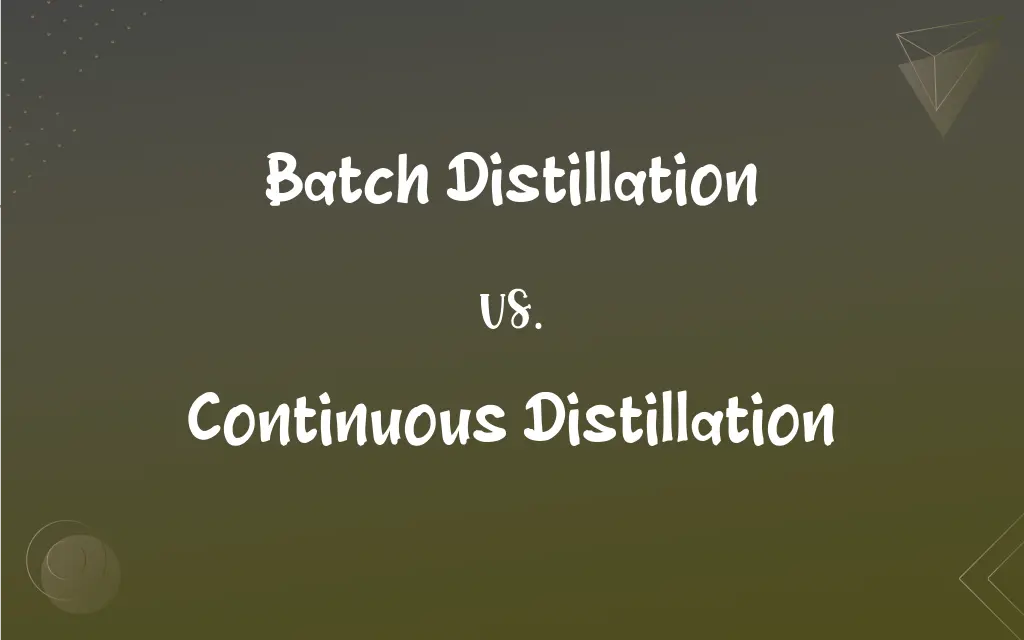Batch Distillation vs. Continuous Distillation: What's the Difference?
Edited by Aimie Carlson || By Janet White || Published on March 24, 2024
Batch distillation processes a fixed amount of feed in cycles, while continuous distillation constantly feeds and distills material without interruption.

Key Differences
Batch distillation and continuous distillation represent two fundamental approaches to separating component mixtures based on differences in volatility. Batch distillation operates by loading a fixed quantity of mixture into a distillation unit, then heating and separating the mixture over time. The process is cyclic, with each batch requiring manual intervention to remove distilled fractions and reload the unit. Continuous distillation, in contrast, involves a constant feed of mixture into the distillation column, with components being separated and extracted simultaneously at different heights of the column without the need to stop the process.
In batch distillation, the composition of the distillate changes over time as the batch progresses, requiring careful monitoring and adjustment to ensure desired separation. This method is ideal for smaller-scale operations, specialty chemicals, or when the production needs vary. Continuous distillation offers a steady state of operation, where the composition of the distillate and residue can remain constant over time. This method is preferred for large-scale industrial operations where high volumes of products are processed, and consistency is key.
The flexibility of batch distillation allows for the adaptation of the process to different mixtures and desired outcomes with each new batch. It is particularly useful for producing high-purity products in smaller quantities or when dealing with variable feedstock compositions. Continuous distillation, however, is more efficient for continuous production, requiring less labor per unit of product and providing a more consistent product quality due to its steady-state operation.
Batch distillation equipment typically has lower initial costs but may incur higher operating costs per unit of product due to less efficient energy use and the need for more frequent operator intervention. Continuous distillation systems, while more expensive to install, operate more efficiently and with lower operating costs over time, making them more economical for high-volume production. The choice between batch and continuous distillation depends on the specifics of the production requirements, including scale, product specifications, and economic considerations.
Batch distillation's suitability for experimental or small-scale production contrasts with continuous distillation's alignment with large-scale, high-volume manufacturing. The operational differences reflect in the design and complexity of the distillation equipment, with batch systems being simpler but less efficient, and continuous systems being more complex but capable of handling large volumes efficiently. These differences underscore the importance of selecting the appropriate distillation method to meet specific production goals and efficiency requirements.
ADVERTISEMENT
Comparison Chart
Operation Mode
Processes in cycles with a fixed amount of feed.
Operates continuously with a constant feed of mixture.
Scale of Production
Suitable for small to medium scale.
Ideal for large-scale production.
Product Consistency
Product consistency can vary within a batch.
Provides a consistent product quality over time.
Flexibility
High flexibility for different products and purities.
Less flexible, typically dedicated to a specific product.
Operating Costs
Higher operating costs per unit of product.
Lower operating costs due to efficiency and scale.
ADVERTISEMENT
Batch Distillation and Continuous Distillation Definitions
Batch Distillation
Manual intervention required.
Operators manually collected the distillate from the batch distillation unit.
Continuous Distillation
Consistent product output.
The continuous distillation process ensures a uniform quality of distilled water.
Batch Distillation
Ideal for experimental work.
Batch distillation was chosen for the experimental separation of the new compound.
Continuous Distillation
Suited for large industries.
Chemical manufacturers prefer continuous distillation for its efficiency at scale.
Batch Distillation
Varied product quality.
Each batch distillation produced slightly different purities of the final product.
Continuous Distillation
Lower operating costs.
Continuous distillation reduces costs through its efficient, ongoing operation.
Batch Distillation
Cyclic separation process.
The laboratory used batch distillation to purify the solvent.
Continuous Distillation
Steady-state operation.
The refinery relies on continuous distillation for uninterrupted fuel production.
Batch Distillation
Flexible for varied products.
Batch distillation allows customization for each unique product.
Continuous Distillation
High-volume processing.
Continuous distillation supports the constant demand for ethanol.
FAQs
When is batch distillation preferred?
It's preferred for small-scale operations, high-purity separations, and when handling multiple products with variable production schedules.
What is batch distillation?
Batch distillation is a separation process where a mixture is heated in a single distillation unit to separate its components over time, processing one batch at a time.
How does batch distillation work?
It involves heating a liquid mixture in a distillation flask, vaporizing the more volatile components, which are then condensed and collected separately.
How does the boiling point difference affect batch distillation?
Larger boiling point differences between components make separation easier and more efficient.
Can batch distillation separate multi-component mixtures?
Yes, but it may require multiple distillation stages or a more complex setup to achieve desired separations.
What is continuous distillation?
Continuous distillation is a process where a liquid mixture is continuously fed into the distillation unit, and separated components are continuously removed, allowing for ongoing operation.
How does continuous distillation work?
It uses a vertical column with a feed input at a certain point. As the mixture boils, components separate based on volatility, with lighter components collected at the top and heavier ones at the bottom.
What are the key components of a batch distillation setup?
A typical setup includes a distillation flask, heating source, condenser, and collection vessels for distillate.
What are the advantages of batch distillation?
Flexibility in operation, suitability for small volumes, and ability to produce high-purity products.
What are the limitations of batch distillation?
Lower efficiency and higher labor and energy costs per unit of product compared to continuous distillation.
What are the disadvantages of continuous distillation?
High initial investment, less flexibility in changing production output, and complexity in operation and maintenance.
How is a continuous distillation column structured?
It consists of a vertical column packed with materials or trays to facilitate vapor-liquid contact, a reboiler to generate vapors, and a condenser to collect distillate.
How is the efficiency of batch distillation measured?
Efficiency is often measured by the purity of the output and the yield of desired product relative to input material.
How does energy efficiency compare between batch and continuous distillation?
Continuous distillation is generally more energy-efficient due to its ongoing operation and optimized energy recovery systems.
Can batch distillation be automated?
Yes, modern batch distillation processes can be automated to control temperatures and flow rates for improved efficiency and consistency.
How is the purity of products controlled in continuous distillation?
By adjusting the reflux ratio, feed rate, and column operating conditions to achieve the desired separation.
What are the main advantages of continuous distillation?
Higher efficiency, better suited for large-scale production, and lower labor costs per unit of product.
Can continuous distillation handle multiple feedstocks?
It can, but requires careful planning and design to accommodate varying feed compositions and desired outputs.
What industries commonly use continuous distillation?
Petroleum refining, chemical manufacturing, and large-scale alcohol production.
What factors influence the performance of continuous distillation?
Feed composition, column pressure, temperature profiles, and the efficiency of trays or packing material.
About Author
Written by
Janet WhiteJanet White has been an esteemed writer and blogger for Difference Wiki. Holding a Master's degree in Science and Medical Journalism from the prestigious Boston University, she has consistently demonstrated her expertise and passion for her field. When she's not immersed in her work, Janet relishes her time exercising, delving into a good book, and cherishing moments with friends and family.
Edited by
Aimie CarlsonAimie Carlson, holding a master's degree in English literature, is a fervent English language enthusiast. She lends her writing talents to Difference Wiki, a prominent website that specializes in comparisons, offering readers insightful analyses that both captivate and inform.































































